 | –≠–ª–µ–∫—Ç—Ä–æ–Ω–Ω—ã–π –∫–æ–º–ø–æ–Ω–µ–Ω—Ç: ML2201 | –°–∫–∞—á–∞—Ç—å:  PDF PDF  ZIP ZIP |

FEDL2201-01
1Semiconductor
This version: Mar. 2000
ML2201-XXX
Speech Synthesizer LSI with on-chip 384K Mask ROM
1/20
GENERAL DESCRIPTION
The ML2201 is a PCM-based speech synthesizer LSI having an on-chip 384K Mask ROM, D/A Converter and
Low Pass Filter. Utilizing the serial interface enables smaller footprint packaging, which makes the chip an ideal
choice for a pre-recorded message subsystem used with today's size-critical applications.
FEATURES
∑
Sampling Frequency (Selectable for each single phrase)
4.0/5.3/6.4/8.0/10.6/12.8/16.0 kHz
∑
On-chip 384 Kbit Mask ROM
∑
Maximum Playback Time (At f
EXTCLK
= 4.096 MHz)
12.0 sec
At f
SAM
= 4.0 kHz
6.0 sec
At f
SAM
= 8.0 kHz
3.0 sec
At f
SAM
= 16.0 kHz
∑
External Clock Frequency Range *
f
EXTCLK
= 3.5 to 4.096 MHz (Typ.) to 17.0 MHz
∑
On-chip Phrase Control Table
∑
Maximum Number of Phrases:
31 Phrases
∑
Built-in 10-bit Current-Output Type D/A Converter
∑
Built-in LPF
∑
Packaging:
8-pin Plastic SSOP (SSOP8-P-44-0.65-K)
(Product Code: ML2201-XXX MBZ060)
∑
Power Supply Voltage:
+2.0 to +5.5 V
* Note:
As of February 2000, ceramic oscillation on this chip is under development and thus the chip is not
functional with a ceramic oscillator. The manufacturer intends to add a ceramic oscillation option to the
chip. For more information on availability in commercial quantity, contact your sales representative.
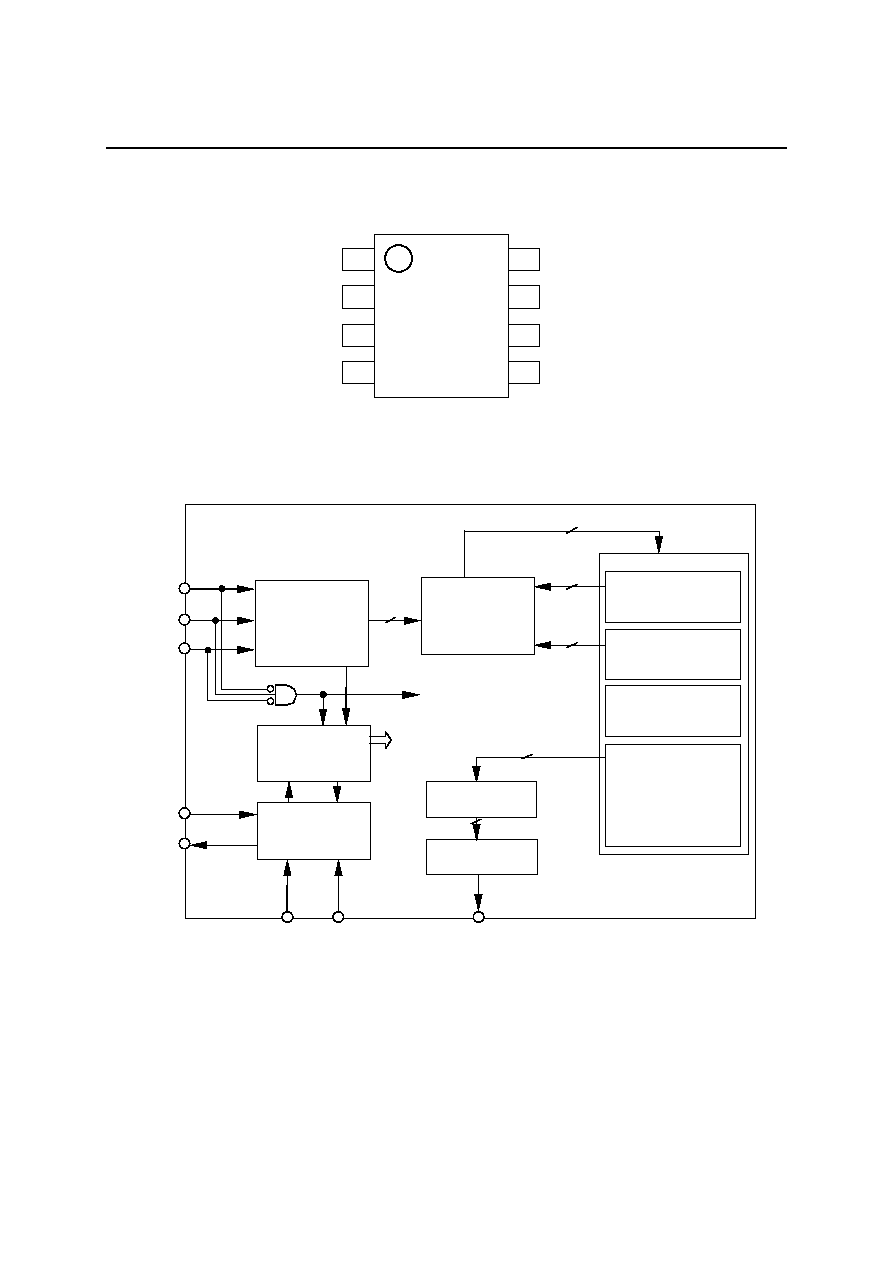
FEDL2201-01
1Semiconductor
ML2201≠XXX
2/20
PIN LAYOUT (TOP VIEW)
GND
AOUT
XT
V
DD
1
2
3
4
8
7
6
5
PDWN
XT
ST
PI
8-Pin Plastic SSOP
BLOCK DIAGRAM
AOUT
GND
V
DD
PDWN
384 Kbit ROM
10 bit DAC
LPF
XT
16 bit Address
controller
XT
ST
PI
OSC
Circuit
10
Timing
Controller
Serial
Interface
8
8
PCM data Area
378 Kbit
Edit ROM 2 Kbit
(Phrase Control Table)
Address ROM 2 Kbit
(Phrase Address Table)
Test ROM 2 Kbit
8
5
Reset, Power Down
16
PCM
Synthesizer

FEDL2201-01
1Semiconductor
ML2201≠XXX
3/20
PIN DESCRIPTION
Pin No.
Pin Name
I/O
Description
1
ST
I
The playback trigger pin.
The number of pulses input to the
PI
pin, while this pin is held "L",
determines the Phrase Address for playback. At the
ST
's rising edge, the
phrase address data is loaded into the LSI and playback starts. When no
pulse input to
PI
occurs while this pin is held "L", the LSI recognizes it as the
"Stop Code" that results in stopping playback.
2
PI
I
The address input pin.
The number of pulses input to this pin, while the
ST
pin is held "L",
determines the Phrase Address for playback.
When 32 pulses are input, the internal counter returns to its initial value, "0".
3
GND
--
The ground pin.
4
AOUT
O
The analog output pin.
Configured as N-MOS open drain, analog signal is output in the form of
change in output (attraction) current. While the
PDWN
pin being held "H",
this pin is sustained at 1/2 level and thus the current keeps on flowing.
When shifting to standby state and shifting back to ready state from
standby, the pop-noise canceller is put to work.
5
V
DD
--
The power supply pin.
Insert a 0.1
µ
F bypass capacitor between this pin and the GND pin.
6
XT
I
The external clock input pin.
The ceramic resonator connection pin for ceramic oscillation option under
development.
7
XT
O
Keep this pin open.
The LSI's operations may become unstable if this pin includes any
capacitive component.
The ceramic resonator connection pin for ceramic oscillation option under
development.
8
PDWN
I
The power down pin.
The LSI stays standby state while the pin being held "L".
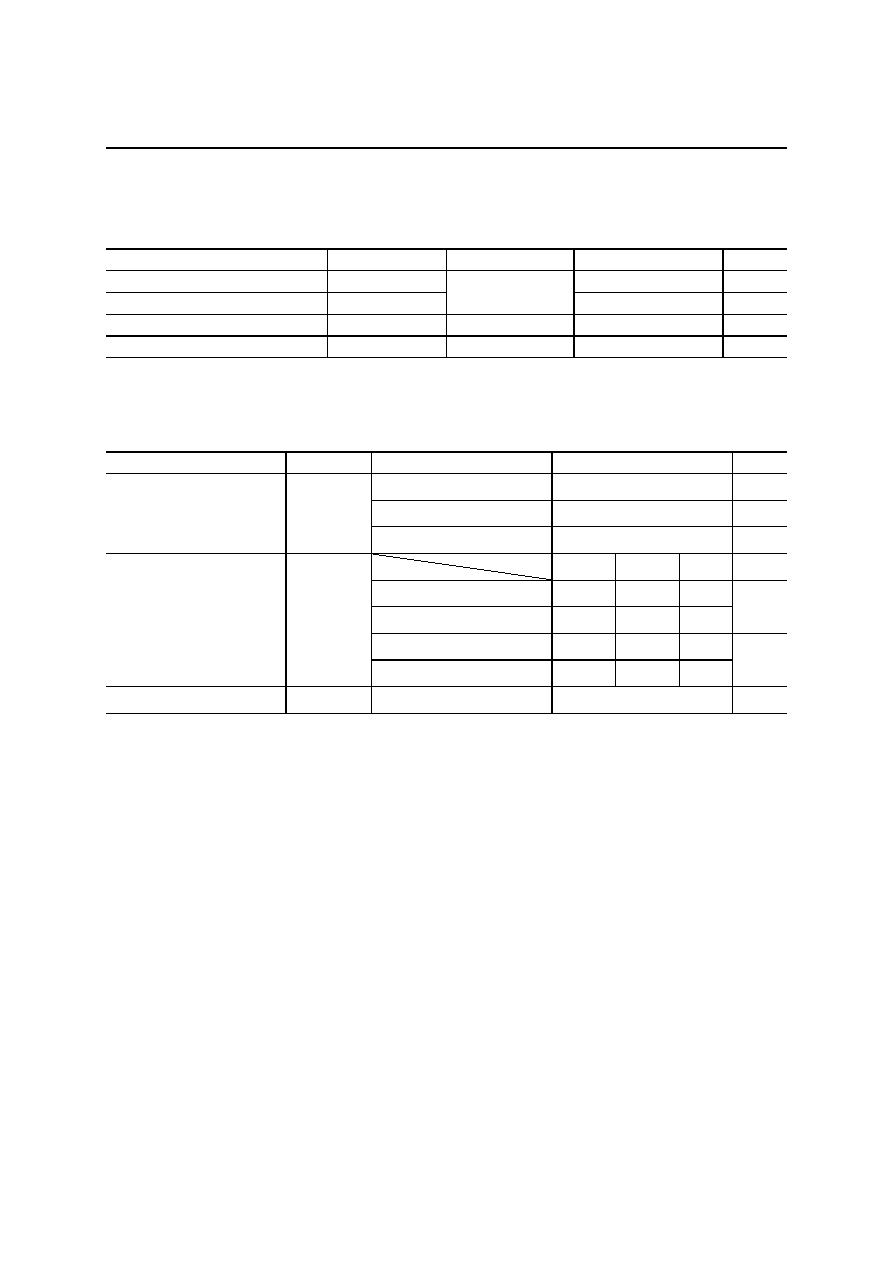
FEDL2201-01
1Semiconductor
ML2201≠XXX
4/20
ABSOLUTE MAXIMUM RATINGS
(GND = 0 V)
Parameter
Symbol
Condition
Rating
Unit
Power Supply Voltage
V
DD
≠0.3 to +7.0
V
Input Voltage
V
IN
Ta = 25∞C
≠0.3 to V
DD
+0.3
V
Storage Temperature
T
STG
--
≠55 to +150
∞C
Power Drain Allowance
Pd
Ta = 25∞C
250
mW
RECOMMENDED OPERATING CONDITIONS
(GND = 0 V)
Parameter
Symbol
Condition
Range
Unit
f
EXTCLK
= 3.5 to 4.5 MHz
+2.0 to +5.5
V
f
EXTCLK
= 3.5 to 13.5 MHz
+2.6 to +5.5
V
Power Supply Voltage
V
DD
f
EXTCLK
= 3.5 to 17.0 MHz
+3.0 to +5.5
V
Min.
Typ.
Max.
MHz
V
DD
= 2.0 to 5.5 V
3.5
4.096
4.5
V
DD
= 2.6 to 5.5 V
3.5
--
13.5
V
DD
= 2.7 to 5.5 V
3.5
--
14.5
External Clock Frequency
f
EXTCLK
V
DD
= 3.0 to 5.5 V
3.5
--
17.0
Operating Temperature
T
OP
--
≠40 to +85
∞C
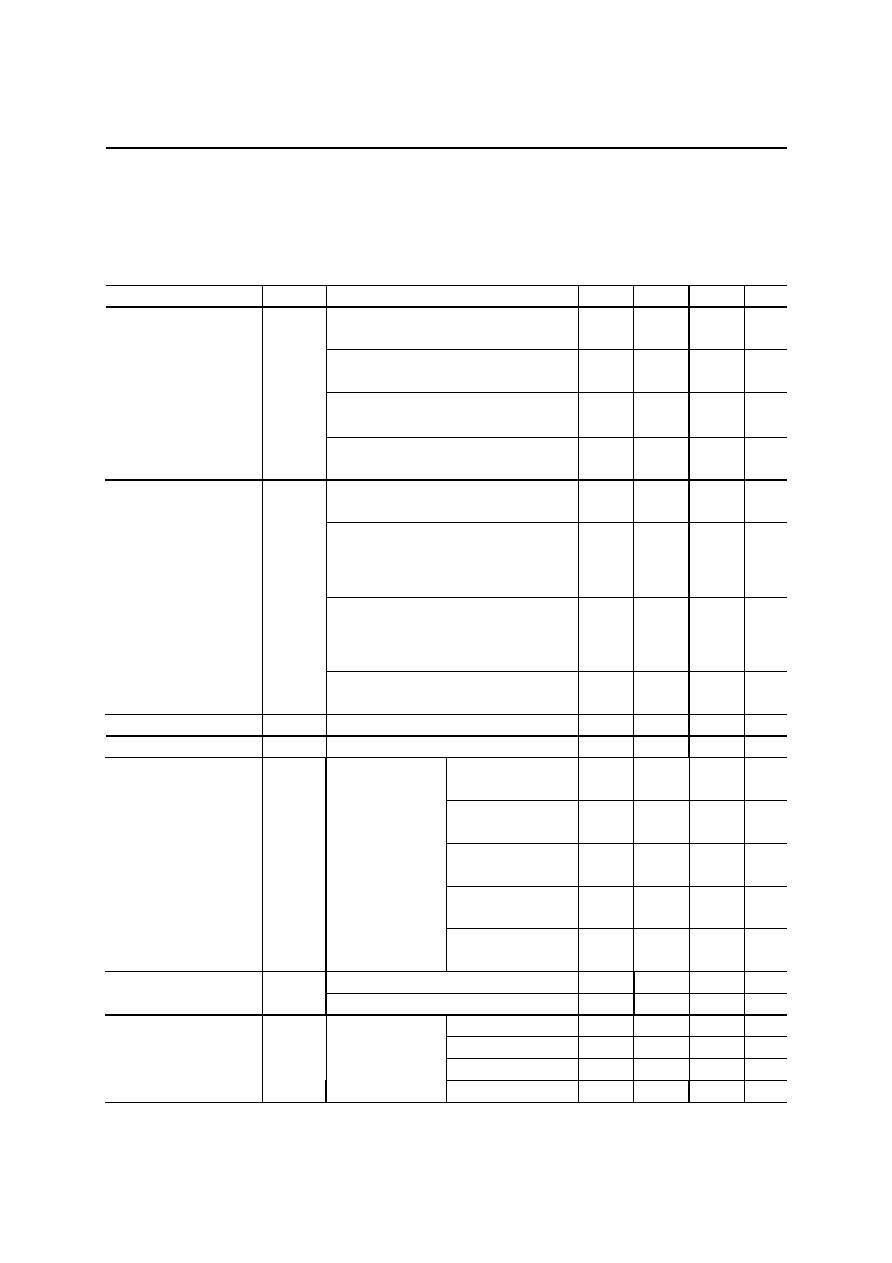
FEDL2201-01
1Semiconductor
ML2201≠XXX
5/20
ELECTRICAL CHARACTERISTICS
DC Characteristics
V
DD
= 2.0 to 5.5 V, GND = 0 V, f
EXTCLK
= 4.096 MHz, Ta = ≠40 to +85∞C (unless otherwise specified)
Parameter
Symbol
Condition
Min.
Typ.
Max.
Unit
F
EXTCLK
>
14.5 MHz
V
DD
= 3.0 to 5.5 V
V
DD
◊
0.85
--
--
V
f
EXTCLK
14.5 MHz
V
DD
= 2.7 to 5.5 V
V
DD
◊
0.8
--
--
V
f
EXTCLK
13.5 MHz
V
DD
= 2.6 to 2.7 V
V
DD
◊
0.85
--
--
V
"H" Input Voltage
V
IH
f
EXTCLK
4.5 MHz
V
DD
= 2.0 to 5.5 V
V
DD
◊
0.8
--
--
V
F
EXTCLK
>
14.5 MHz
V
DD
= 3.0 to 5.5 V
--
--
V
DD
◊
0.15
V
f
EXTCLK
14.5 MHz
V
DD
= 2.7 to 5.5 V
--
--
V
DD
◊
0.2
V
f
EXTCLK
13.5 MHz
V
DD
= 2.6 to 2.7 V
--
--
V
DD
◊
0.15
V
"L" Input Voltage
V
IL
f
EXTCLK
4.5 MHz
V
DD
= 2.0 to 5.5 V
--
--
V
DD
◊
0.2
V
"H" Input Current
I
IH
V
IH
= V
DD
--
--
10
µ
A
"L" Input Current
I
IL
V
IL
= GND
≠10
--
--
µ
A
V
DD
= 5.5 V
f
EXTCLK
= 4.096 MHz
--
1.7
3.9
mA
V
DD
= 3.0 V
f
EXTCLK
= 4.096 MHz
--
0.9
2.1
mA
V
DD
= 2.0 V
f
EXTCLK
= 4.096 MHz
--
0.5
1.4
mA
V
DD
= 5.5 V
f
EXTCLK
= 16 MHz
--
4.6
12.0
mA
Supply Current
I
DD
Except AOUT
output current
V
DD
= 3.0 V
f
EXTCLK
= 16 MHz
--
1.8
6.5
mA
Ta = ≠40 to +70
∞
C
--
--
10
µ
A
Standby Current
I
DS
Ta = ≠40 to +85∞C
--
--
50
µ
A
V
DD
= 2.0 to 5.5 V
0.5
--
10.0
mA
V
DD
= 5.5 V
4.3
6.8
10.0
mA
V
DD
= 3.0 V
1.4
2.7
3.9
mA
AOUT Output Current
I
AOUT
At max.
output current
V
DD
= 2.0 V
0.5
1.2
2.2
mA

FEDL2201-01
1Semiconductor
ML2201≠XXX
6/20
AC Characteristics
V
DD
= 2.0 to 5.5 V, GND = 0 V, f
EXTCLK
= 4.096 MHz, Ta = ≠40 to +85∞C (unless otherwise specified)
Parameter
Symbol
Condition
Min.
Typ.
Max.
Unit
Clock Oscillation Duty Cycle
f
DUTY
--
40
50
60
%
Reset Input Time after Powering Up
t
RST
--
10
--
--
µ
s
PDWN
Hold Time after Reset Input
t
PDH
--
10
--
--
µ
s
D/A Converter Transit Time
(Pop-Noise Canceller Work Time)
Note *1
t
DAR
, t
DAF
--
60
64
68
ms
PDWN
≠
ST
Setup Time
t
PDSS
--
1
--
--
µ
s
ST
≠
PI
Setup Time
t
SPS
--
1
--
--
µ
s
PI
Pulse Width
t
PW
--
0.35
--
2000
µ
s
PI
Cycle Time
t
PC
--
0.7
--
4000
µ
s
ST
≠
PI
Hold Time
t
SPH
--
1
--
--
µ
s
ST
≠ AOUT Setup Time
Note *2
t
SAS
At f
SAM
= 8.0 kHz
--
1050
µ
s
Phrase Stop Time
Note *2
t
DPS
At f
SAM
= 8.0 kHz
--
700
µ
s
Silence Time between Phrases
Note *2
t
BLN
At f
SAM
= 8.0 kHz
--
700
µ
s
Stop
ST
Pulse Width
t
SSW
--
0.35
--
2000
µ
s
Phrase
ST
≠ Phrase
ST
Pulse Duration
Note *2
t
PP
At f
SAM
= 8.0 kHz
1050
--
--
µ
s
Phrase
ST
≠ Stop
ST
Pulse Duration
Note *2
t
PS
At f
SAM
= 8.0 kHz
1050
--
--
µ
s
Stop
ST
≠ Phrase
ST
Pulse Duration
Note *2
t
SP
At f
SAM
= 8.0 kHz
500
--
--
µ
s
Sampling Frequency
Note *3
f
SAM
--
3.9
--
28.0
kHz
Note *1: The value changes in proportion to the external clock frequency, f
EXTCLK
.
Note *2: The value changes in proportion to the sampling frequency, f
SAM
.
Note *3: The sampling frequency is determined by the external clock frequency, f
EXTCLK
, and the dividing
factor that is selected for each phrase.

FEDL2201-01
1Semiconductor
ML2201≠XXX
7/20
TIMING DIAGRAMS
Timing Diagram at Powering On
V
DD
PDWN
t
RST
t
PDH
ST
PI
Reset
Power Down
NOTE: The LSI's reset operation can be performed by using a level input combination of
PDWN
= "L",
ST
= "L" and
PI
= "H". After powering on, the initial reset operation is required at the above timing.
Timing Diagram at Powering Up and Standby State
PDWN
AOUT
1/2 I
AOUT
t
DAR
t
DAF
Timing Diagram for Playback
PDWN
ST
PI
......
t
PDSS
t
SPS
AOUT
t
SPH
t
SAS
t
PW
t
PC
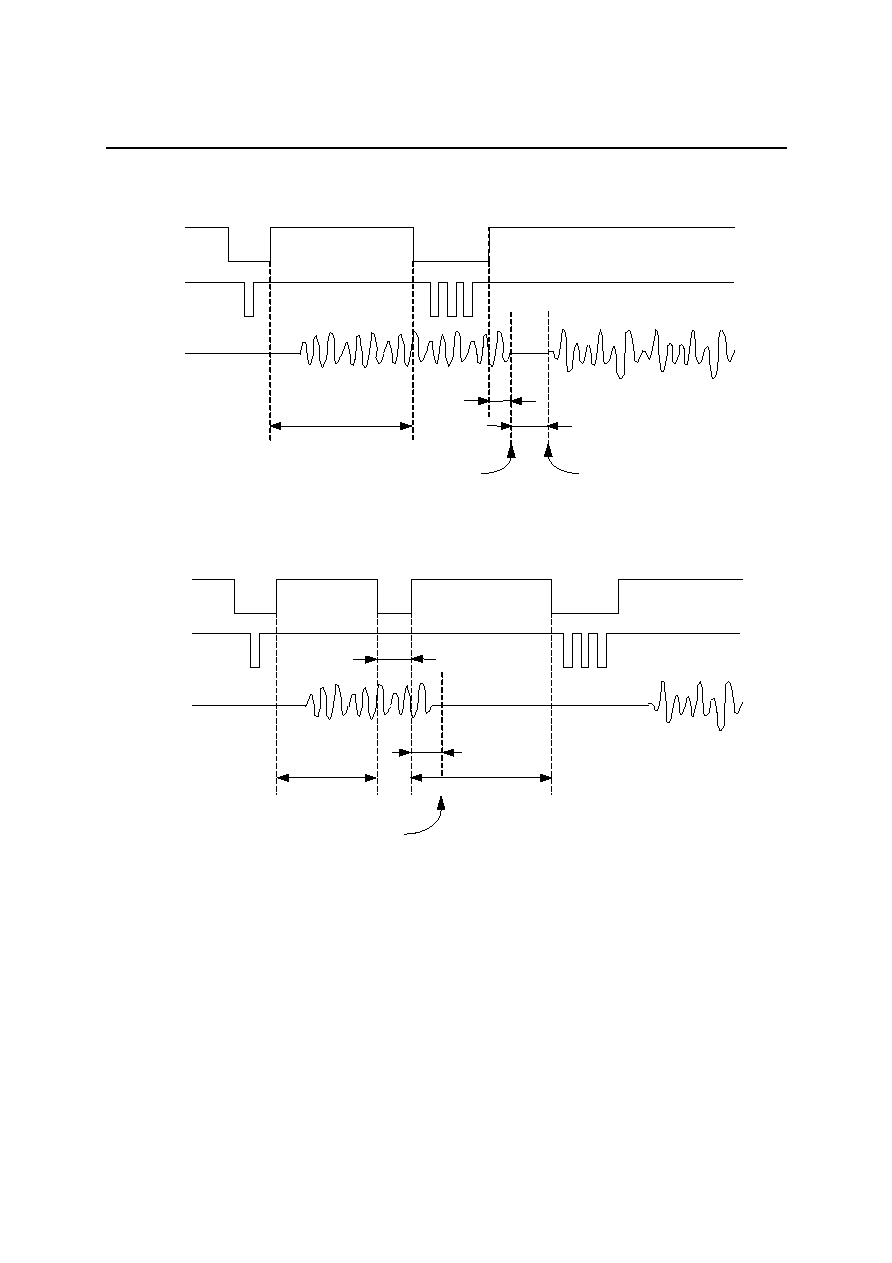
FEDL2201-01
1Semiconductor
ML2201≠XXX
8/20
Timing Diagram on Re-addressing while Playing
ST
PI
t
DPS
t
BLN
AOUT
Stop playing the current phrase
Start playing the next phrase
t
PP
Timing Diagram on Stop Code Input
ST
PI
t
DPS
AOUT
Stop playing the current phrase
t
PS
t
SP
t
SSW

FEDL2201-01
1Semiconductor
ML2201≠XXX
9/20
FUNCTIONAL DESCRIPTION
Sampling Frequency
You can select a sampling frequency for each phrase address from the following list while you are working on
sound data. Select a sampling frequency that satisfies f
SAM
= 3.9 to 28.0 kHz from the values obtained with the
dividing factors as shown in the Table 1 below.
Table 1 Sampling Frequency
Sampling Frequency
At f
EXTCLK
= 4.096 MHz
Dividing Factor
4.0 kHz
f
EXTCLK
/1024
5.3 kHz
f
EXTCLK
/768
6.4 kHz
f
EXTCLK
/640
8.0 kHz
f
EXTCLK
/512
10.6 kHz
f
EXTCLK
/384
12.8 kHz
f
EXTCLK
/320
16.0 kHz
f
EXTCLK
/256
Memory Allocation and Playback Time Length
As shown in the Figure 1, the on-chip Mask ROM of ML2201 is partitioned into four areas, Phrase Control Table,
Address Control Table, Test Data area and User's Data area. The actual data area where user's sound data can be
stored is 378 Kbit, that is the total on-chip Mask ROM capacity minus 6 Kbit.
Phrase Control Table Area
Address Control Table Area
Test Data Area
User's Sound Data Area
2 Kbit
2 Kbit
2 Kbit
378 Kbit
Figure 1 On-chip Mask ROM (384 Kbit) Memory Allocation

FEDL2201-01
1Semiconductor
ML2201≠XXX
10/20
You can calculate playback time length with memory size divided by a bit rate. The following formula can be used
for 8-bit PCM-based ML2201;
Playback Time (sec) =
=
For example, when you store all phrases at 8.0 kHz Sampling Frequency, the maximum playback time is
calculated as follows;
Playback Time (sec) =
6.0 sec
Playback Algorithm
ML2201 uses
OKI
Non-Linear PCM algorithm, an advanced variation of PCM.
In mid-range wave-form, this algorithm has precision and quality equivalent to those of 10-bit Straight PCM.
Inserting Silence
In addition to playing normal recorded sound phrases, ML2201 allows you to insert silence (a silent phrase) . You
can define time length of silence freely in 32 ms steps, within the range of minimum 32 ms and maximum 992 ms
at f
EXTCLK
= 4.096 MHz. Those time length vary in proportion to the external clock frequency, f
EXTCLK
.
Phrase Control Table
The user-definable on-chip Phrase Control Table feature enables you to play back multiple phrases in a single
continuous session with just the same simple control as in a regular single phrase playback. You can assign up to 8
phrases including a silent phrase (s) to a single address. This allows you to get the most out of limited memory
space because you can eliminate duplicate sound data.
As an example, let's assume you want to create several similar phrases like "It will be xxxxx today". "xxxxx" can
be "sunny", "rainy" or "cloudy". The common words such as "It", "will be" and "today" are created separately as
an independent phrase, and phrasing order information is stored in the Phrase Control Table, as shown in the Table
2 and Figure 2.1. From the external control, simply selecting an X address causes the LSI to play multiple phrases
continuously. In this example shown in the Table 2, selecting [01] address starts to play "It will be fine today,
while selecting [02] "It will be rainy today".
You can also insert a silent phrase to the Phrase Control Table without consuming any memory space.
Minimum Time Length of Silence
32 ms
Maximum Time length of Silence
992 ms
Incremental Step
32 ms
Memory Size (Bit)
Bit Rate (bps)
Memory Size (Bit)
Ext. Clock Frequency (Hz)
◊
8
(384 ≠ 6)
◊
1024 Bit
8000 (Hz)
◊
8 Bit

FEDL2201-01
1Semiconductor
ML2201≠XXX
11/20
Table 2 Phrase Control Table Data
No.
X Address
(HEX)
Y Address (Phrasing Order)
(Up to 8 phrases)
Playback
1
01
[01]
[02]
Silence
[04]
[03]
It will be (Silence) fine today.
2
02
[01]
[02]
Silence
[05]
[03]
It will be (Silence) rainy today.
3
03
[01]
[02]
[04]
[09]
[06]
[0A]
[05]
[03]
It will be fine, later cloudy,
occasionally rainy.
:
:
:
30
1 E
31
1 F
Phrase Control Table Data
Address Control Table Data
No.
X Address
Phrasing Order
No.
Y Address
Phrase
1
01
1
[01] "It"
1
01
It
2
02
2
[02] "Will be"
2
02
will be
3
03
3
Silence (64 ms)
3
03
today
4
04
4
[05] "rainy"
4
04
fine
5
05
5
[03] "today"
5
05
rainy
6
06
6
--
6
06
cloudy
7
07
7
--
7
07
snowy
8
08
8
--
8
08
occasionally
9
09
later
10
0A
in some area
Set length of silence
(32 ms
◊
n)
n
Length of
Silence
1
32 ms
2
64 ms
:
:
:
:
:
:
:
:
:
:
:
:
:
:
:
:
:
31
1F
31
992 ms
31
1F
--
Time unit of silence varies
in proportion to the dividing
factor of f
EXTCLK
.
Figure 2.1 Phrase Data Combination for Use with Phrase Control Table
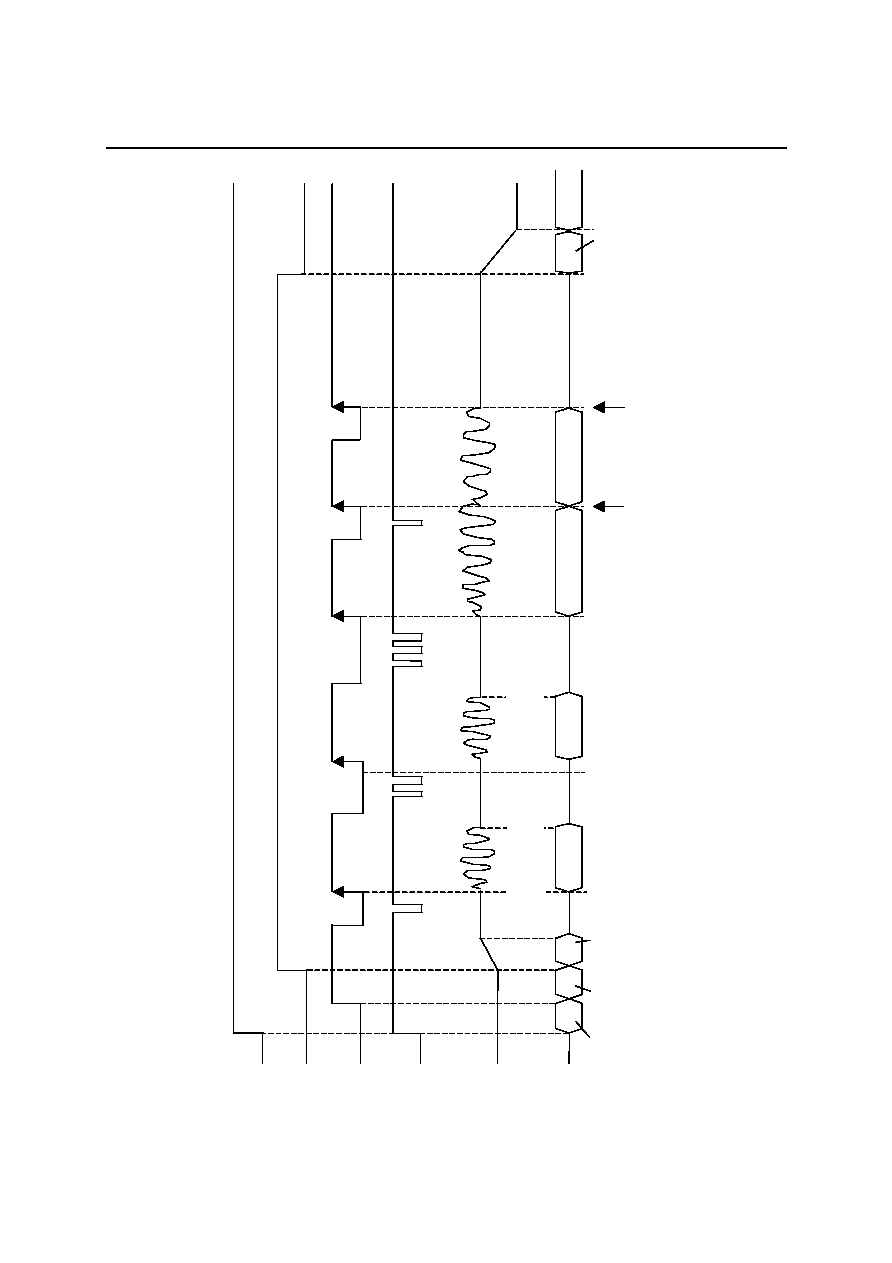
FEDL2201-01
1Semiconductor
ML2201≠XXX
12/20
Figur
e
2
.
2
T
i
ming Dia
g
ra
m for
P
l
a
y
ba
c
k
w
i
th P
h
r
a
s
e
Contr
o
l T
a
ble
Func
tion
S
T
P
I
AOU
T
V
DD
PDW
N
I
t
wi
ll
be f
i
ne t
oday,
la
te
r o
cca
sio
n
a
lly
...
It wil
l
b
e
..........
Res
e
t
P
o
we
r
D
o
wn
S
h
i
f
t
i
ng t
o
S
t
andby
Pla
y
in
g
Pla
y
in
g
Pla
y
in
g
1
s
t P
h
r
a
se
Pla
y
in
g
S
t
op pl
ayi
n
g
t
h
e
earl
i
e
r phras
e
S
t
op pl
ayi
n
g
Stop Cod
e
P
o
we
r
D
o
wn
1st Phr
a
se
3rd Phra
se
2nd Phr
a
se
1st Phr
a
se
3rd Phra
s
e
2nd Phra
s
e
1
s
t P
h
r
a
se
It w
i
l
l
b
e
ra
in
y
t
oday
It w
i
l
l
b
e
fin
e
t
oday
Sh
if
tin
g
to
S
t
andby

FEDL2201-01
1Semiconductor
ML2201≠XXX
13/20
External Clock Input
The Figure 3 shows wiring of an external timing source.
(A type of the external clock should be determined at selecting chip options.)
XT
An external
timing source
Keep this
pin open
XT
Figure 3 External Clock Input
* Note:
As of July 1999, ceramic oscillation on this chip is under development and thus the chip is not
functional with a ceramic oscillator. The manufacturer intends to add a ceramic oscillation option to the
chip. For more information on availability in commercial quantity, contact your sales representative.

FEDL2201-01
1Semiconductor
ML2201≠XXX
14/20
Low Pass Filter
ML2201's analog output goes through the built-in Low Pass Filter. The Figure 4 below shows Frequency
Characteristics and the Table 3 shows Cut-Off Frequency of the LPF.
The LPF's Frequency Characteristics and Cut-Off Frequency change in proportion to the sampling frequency. No
analog output directly from the D/A converter is unavailable on this chip.
20
10
0
≠10
≠20
≠30
≠40
≠50
≠60
≠70
≠80
10
100
1 k
10 k
[Hz]
[dB]
Figure 4 LPF Frequency Characteristics (f
SAM
= 8.0 kHz)
Table 3 LPF Cut-Off Frequency
Sampling Frequency (kHz)
(f
SAM
)
Cut-Off Frequency (kHz)
(f
CUT
)
4.0
1.2
5.3
1.6
6.4
2.0
8.0
2.5
10.6
3.2
12.8
4.0
16.0
5.0

FEDL2201-01
1Semiconductor
ML2201≠XXX
15/20
CONNECTING ML2201 TO A SPEAKER DRIVER
ML2201 uses a D/A converter of current-output type.
To connect ML2201 to a voltage-input type speaker driver, you should convert "Changes in Current" output to
"Changes in Voltage" signal. The following samples show connections of ML2201 and MSC1157 (OKI Speaker
Driver Amplifier) using a resistor (RL) for conversion.
SAMPLE CIRCUIT 1: AT V
DD
= 5.0 V, MSC1157'S Ain AMPLIFICATION = 2.5 V
P-P
MCU
ML2201
MSC1157
P1.2
P1.1
P1.0
PDWN
ST
PI
V
DD
AOUT
V
CC
Ain
430
0.1
µ
F
GND
GND
0.1
µ
F
10
µ
F
47
µ
F
XT
STBY
SEL
VR
4.7
µ
F
SP
SP
+5 V
+5 V
CLK
XT
SAMPLE CIRCUIT 2: AT V
DD
= 3.0 V, MSC1157'S Ain AMPLIFICATION = 1.5 V
P-P
MCU
ML2201
MSC1157
P1.2
P1.1
P1.0
PDWN
ST
PI
V
DD
AOUT
V
CC
Ain
510
0.1
µ
F
GND
GND
0.1 µF
10
µ
F
47
µ
F
XT
STBY
SEL
VR
4.7
µ
F
SP
SP
+3 V
+3 V
CLK
XT
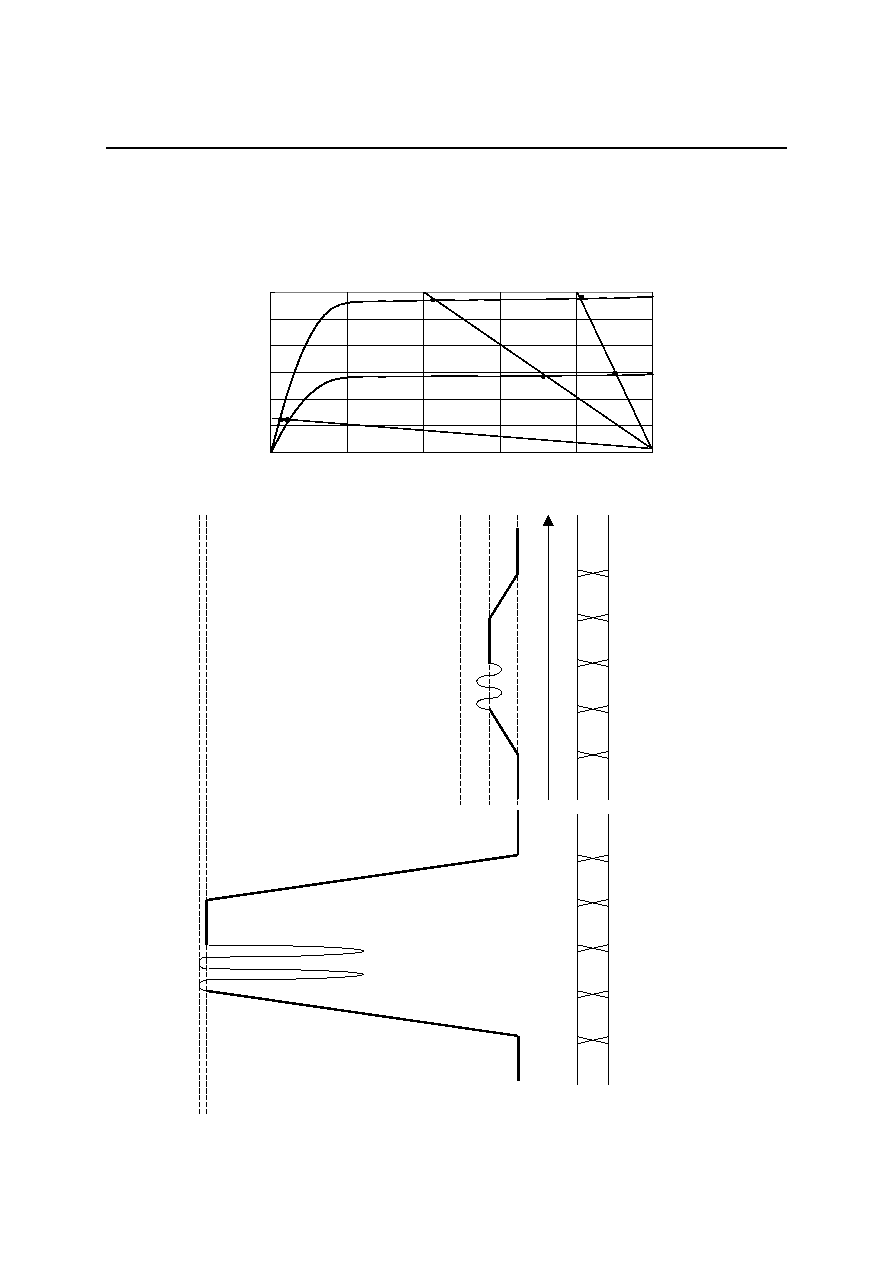
FEDL2201-01
1Semiconductor
ML2201≠XXX
16/20
Co-relationship between output voltage and the value of a resistor for current-voltage conversion is shown in the
figure below. You may want to use the figure as a reference in determining a proper value for the resistor.
AOUT Voltage VS. AOUT Output Current at V
DD
= 5.0 V
RL = 500
0
1
2
3
4
5
6
0
1
2
3
4
5
VAOUT (V)
IA
O
U
T
(m
A
)
RL = 200
RL = 5 k
Po
w
e
r
Do
w
n
Po
w
e
r
Do
w
n
Re
ad
y
Pl
ay
i
n
g
S
h
i
f
ti
n
g
to
St
a
ndb
y
S
h
i
f
ti
n
g
to
St
a
ndb
y
Po
w
e
r
Do
w
n
Po
w
e
r
Do
w
n
Re
ad
y
Pl
ay
i
n
g
S
h
i
f
ti
n
g
to
St
a
ndb
y
S
h
i
f
ti
n
g
to
St
a
ndb
y
(1)
A
t
RL =
200
Pr
o
p
er
w
a
vefor
m
o
u
t
p
u
t
show
n.
(2)
A
t
R
L
=
5 k
Dis
tor
t
ed w
a
v
e
form a
nd o
b
v
i
ou
s
p
o
p
-
n
o
i
se sh
ow
n.

FEDL2201-01
1Semiconductor
ML2201≠XXX
17/20
A SAMPLE CHARACTERISTICS OF D/A CONVERTER OUTPUT CURRENT
0
1
2
3
4
5
6
7
8
0
1
2
3
4
5
6
V
DD
(V)
IA
O
U
T
(m
A)
A Sample Characteristics : Power Supply Voltage VS. AOUT Output Current
(Ta = 25∞C, VAOUT = V
DD
, PCM at Max. level)
0
1
2
3
4
5
6
7
8
≠40
≠20
0
20
40
60
80
100
A Sample Characteristics : Operating Temperature VS. AOUT Output Current
(VAOUT = V
DD
, PCM at Max. level)
Ta (∞C)
IA
O
U
T
(m
A)
V
DD
= 5 V
V
DD
= 3 V
0
1
2
3
4
5
6
0
1
2
3
4
5
A Sample Characteristics: Voltage on AOUT Pin VS. AOUT Output Current
(Ta = 25∞C, PCM at Max. level)
VAOUT (V)
IA
O
U
T
(m
A)
V
DD
= 5 V
V
DD
= 3 V

FEDL2201-01
1Semiconductor
ML2201≠XXX
18/20
NOTES ON USAGE
Type of the Built-in D/A Converter
ML2201 has the built-in current-output type D/A converter and thus the design of analog output circuit is different
from the one with a voltage-output type D/A converter (e.g. MSM6650 family).
ML2201's D/A converter is designed as current attraction type with the same circuit configuration with the one
used on MSM9831. So, the analog output circuit is different from MSM9800 family that uses a current discharge
type D/A converter. (See the table below)
Product
D/A Converter Type
D/A Converter Output Circuit
ML2201
Current Output
N-MOS Open Drain
MSM9831
Current Output
N-MOS Open Drain
MSM9800 Family
Current Output
P-MOS Open Drain
MSM6650 Family
Voltage Output
--
A sample circuit of connecting ML2201 and an amplifier chip
D/A Converter
V
DD
GND
AOUT
ML2201
A resistor for converting current to voltage
AMP
Direction of flowing current
A sample circuit of connecting MSM9800 family and an amplifier chip
D/A Converter
V
DD
GND
AOUT
MSM9800 Family
A resistor for converting current to voltage
AMP
Direction of flowing current
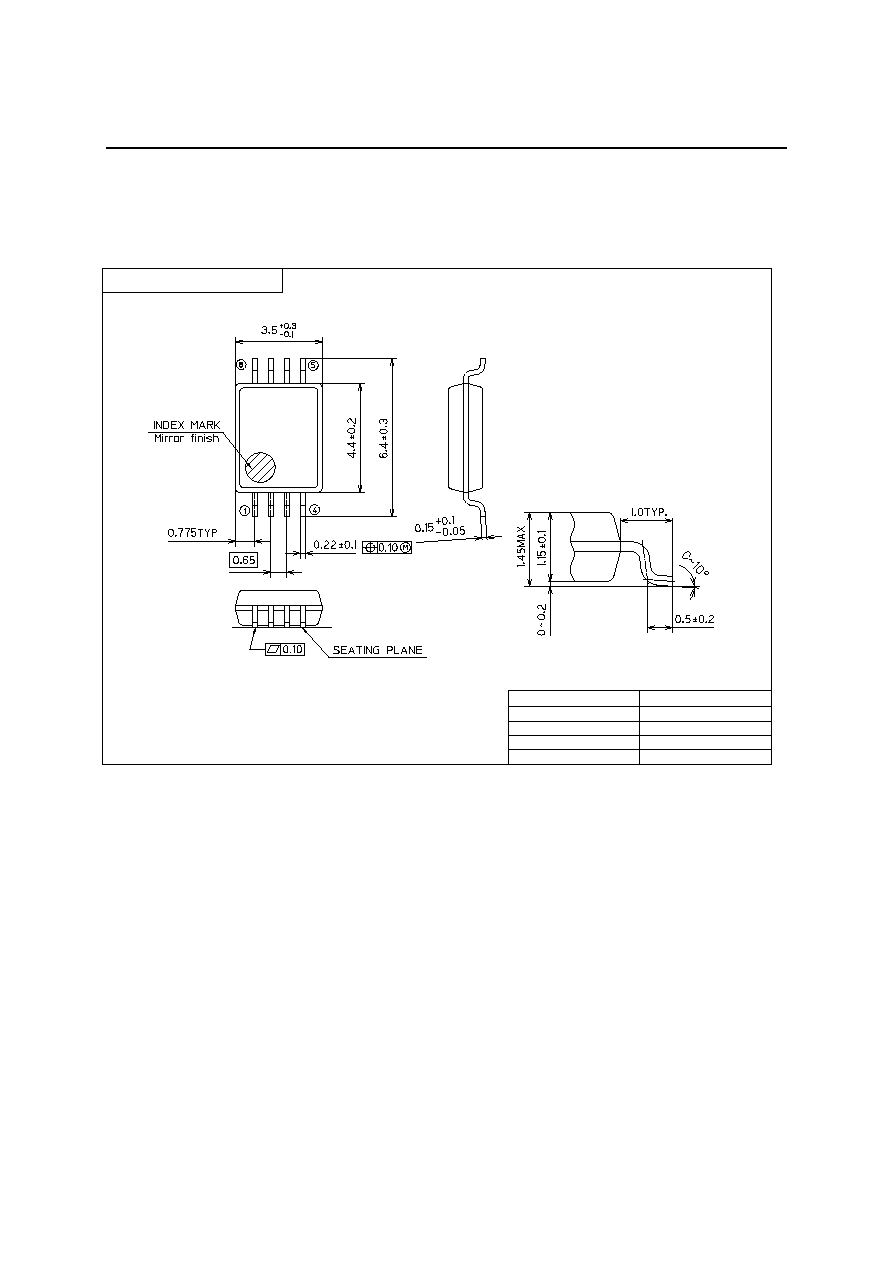
FEDL2201-01
1Semiconductor
ML2201≠XXX
19/20
PACKAGE DIMENSIONS
Notes for Mounting the Surface Mount Type Packages
The surface mount type packages are very susceptible to heat in reflow mounting and humidity
absorbed in storage.
Therefore, before you perform reflow mounting, contact Oki's responsible sales person on the product
name, package name, pin number, package code and desired mounting conditions (reflow method,
temperature and times).
SSOP8-P-44-0.65-K
5
Package material
Lead frame material
Pin treatment
Package weight (g)
Rev. No./Last Revised
Epoxy resin
42 alloy
Solder plating (
5µm)
0.044 TYP.
1/May.12,1999
(Unit: mm)

FEDL2201-01
1Semiconductor
ML2201≠XXX
20/20
NOTICE
1.
The information contained herein can change without notice owing to product and/or technical improvements.
Before using the product, please make sure that the information being referred to is up-to-date.
2.
The outline of action and examples for application circuits described herein have been chosen as an
explanation for the standard action and performance of the product. When planning to use the product, please
ensure that the external conditions are reflected in the actual circuit, assembly, and program designs.
3.
When designing your product, please use our product below the specified maximum ratings and within the
specified operating ranges including, but not limited to, operating voltage, power dissipation, and operating
temperature.
4.
Oki assumes no responsibility or liability whatsoever for any failure or unusual or unexpected operation
resulting from misuse, neglect, improper installation, repair, alteration or accident, improper handling, or
unusual physical or electrical stress including, but not limited to, exposure to parameters beyond the specified
maximum ratings or operation outside the specified operating range.
5.
Neither indemnity against nor license of a third party's industrial and intellectual property right, etc. is
granted by us in connection with the use of the product and/or the information and drawings contained herein.
No responsibility is assumed by us for any infringement of a third party's right which may result from the use
thereof.
6.
The products listed in this document are intended for use in general electronics equipment for commercial
applications (e.g., office automation, communication equipment, measurement equipment, consumer
electronics, etc.). These products are not authorized for use in any system or application that requires special
or enhanced quality and reliability characteristics nor in any system or application where the failure of such
system or application may result in the loss or damage of property, or death or injury to humans.
Such applications include, but are not limited to, traffic and automotive equipment, safety devices, aerospace
equipment, nuclear power control, medical equipment, and life-support systems.
7.
Certain products in this document may need government approval before they can be exported to particular
countries. The purchaser assumes the responsibility of determining the legality of export of these products
and will take appropriate and necessary steps at their own expense for these.
8.
No part of the contents contained herein may be reprinted or reproduced without our prior permission.
Copyright 2000 Oki Electric Industry Co., Ltd.



















